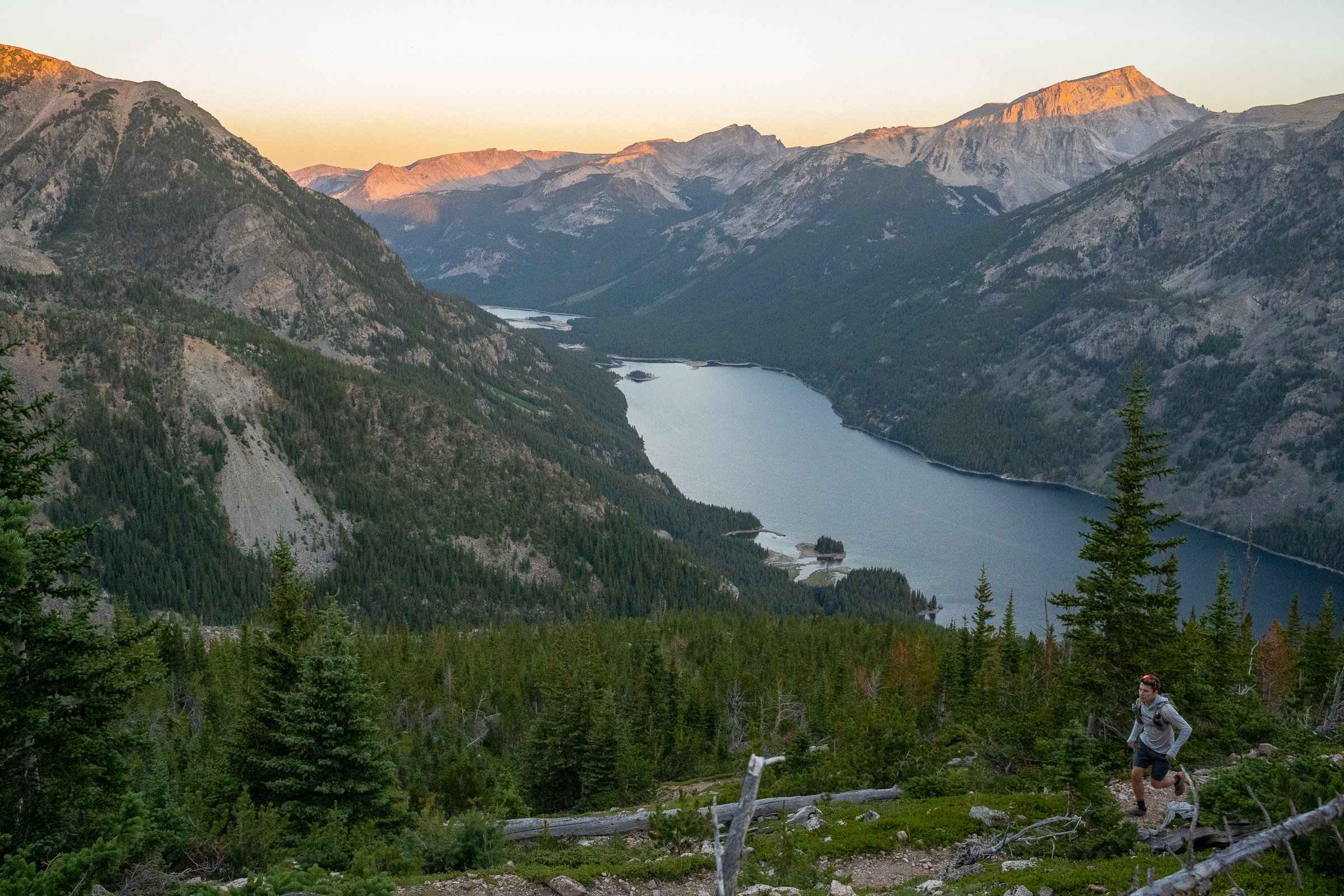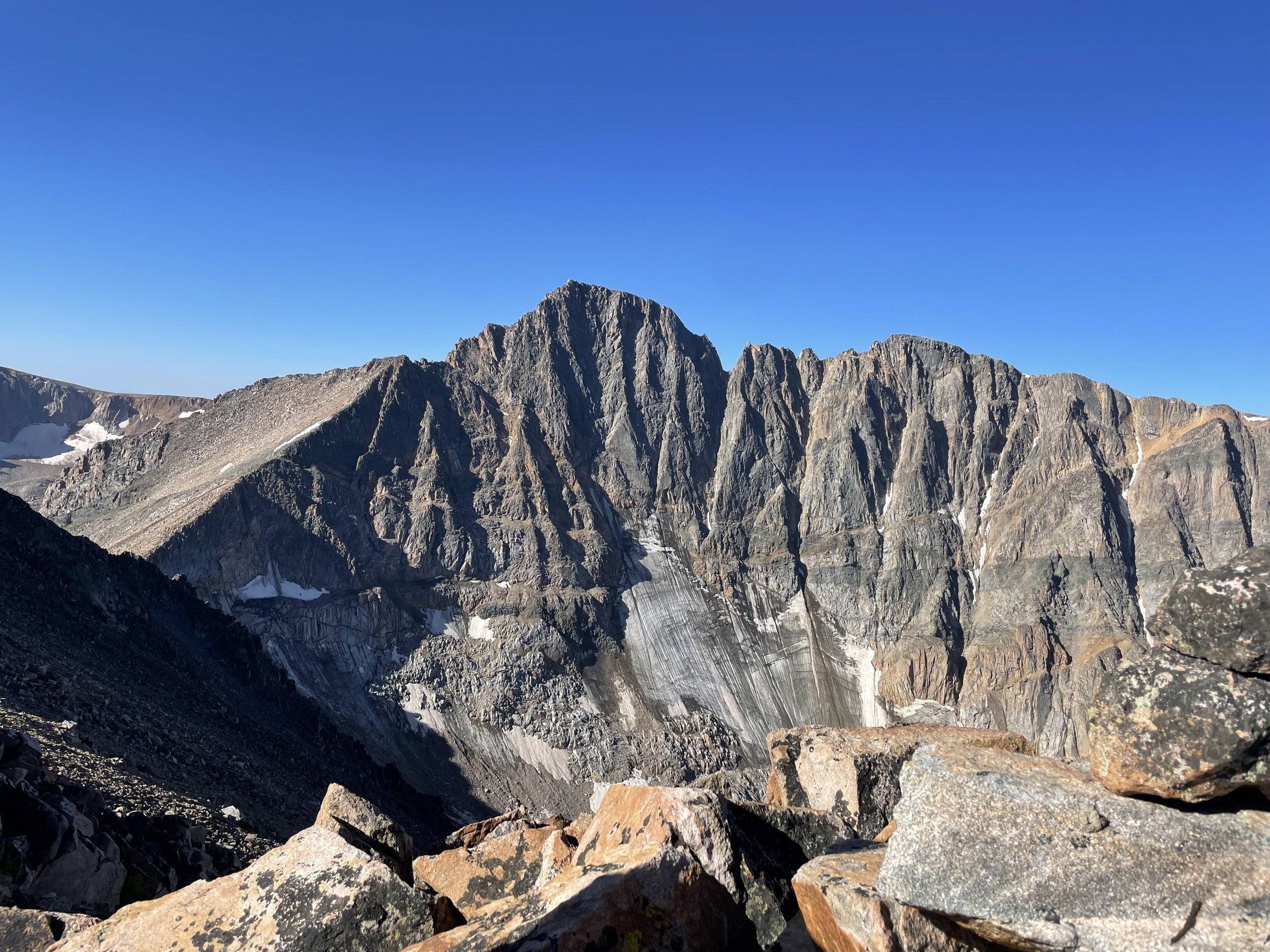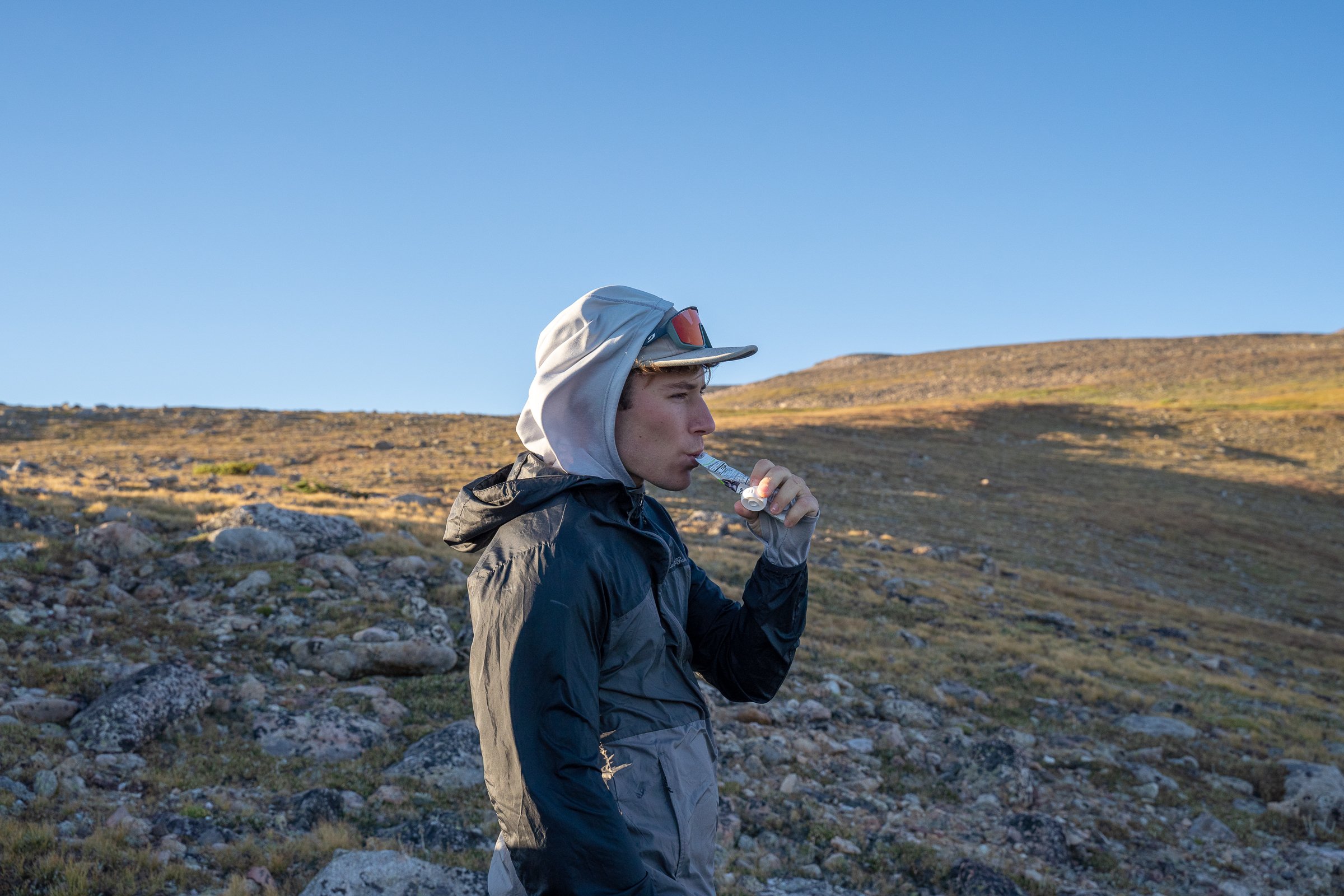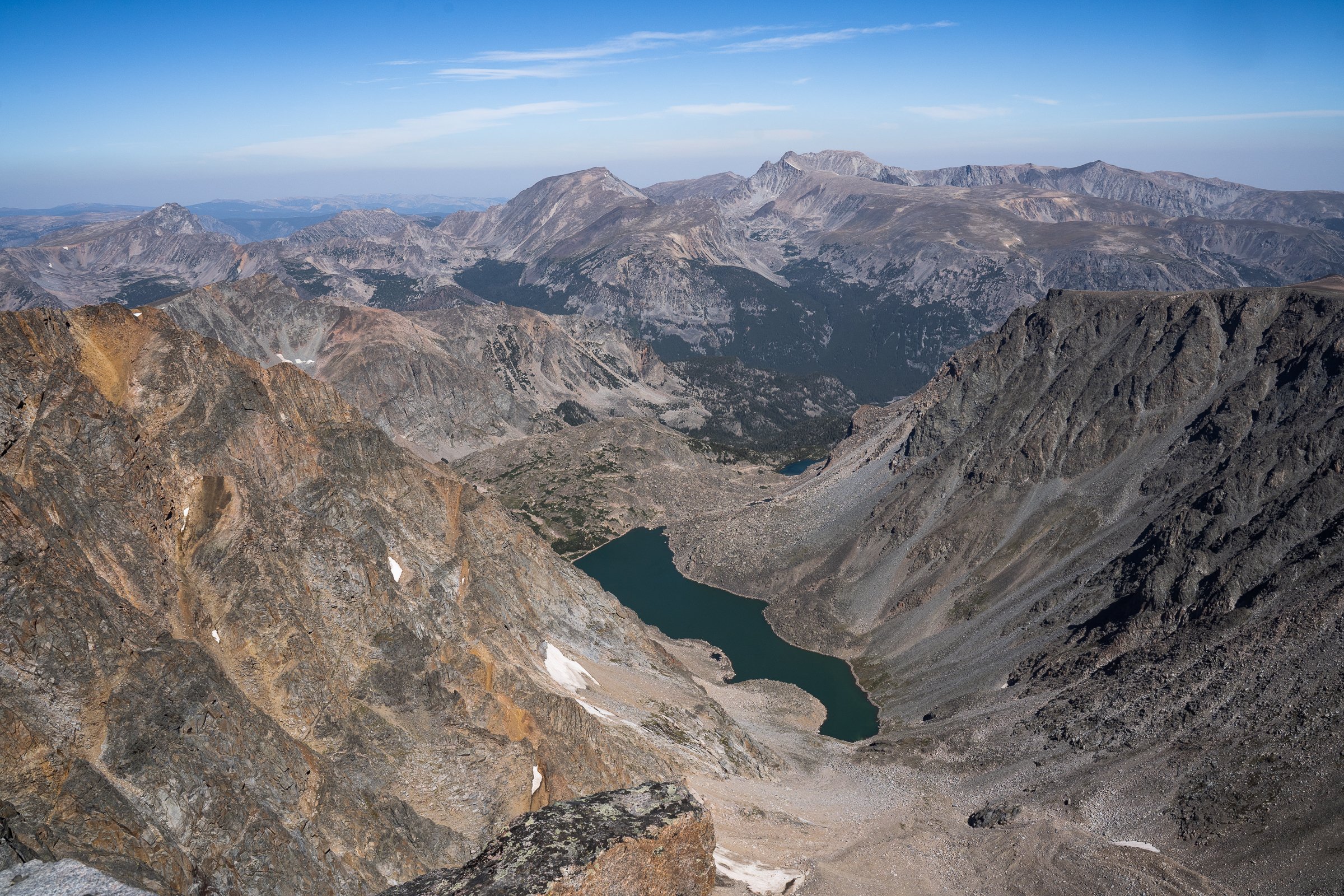A Single Push
Moving light and fast in the mountains has never been an anomaly when speaking of objectives for climbers, skiers, runners and others, but there is something invigorating and energizing about moving like this. It seems every week whether it’s a friend, long-lost acquaintance or professional, people are squeezing things that seem to be multi-day adventures into the small 24-hour time frame we have in a day. As Montana’s highpoint, Granite Peak, looms high within the Absaroka-Beartooth Wilderness and what feels like only an earshot away from my home for such a grandiose peak, I felt like pushing my physical and mostly mental capabilities in the light-and-fast style. By no means are we the first, last, or only party on that sunny September day to summit Granite Peak in a singular push — but that’s besides the point; enjoying moving through wilderness and mountainous terrain is unique to everybody, and by ascending Granite peak this way was just another way to find stoke in the mountains.
The alarm was blaring in my eardrum at 1:20 a.m. along with a text that said, “You up?,” from Kergis who was planning on picking me up at 2 a.m. I wiped my groggy eyes from the midnight nap that was about four hours, got dressed and made my way to the kitchen. The smell of burnt bacon wafted through my nose thanks to my lackadaisical focus cooking, while also regretfully downing a various assortment of foods that included teriyaki jerky, all of which were not enticing to eat as I already began to regret another alpine start.
Ophelia’s lights flashed me with ungodly brightness as I trotted out of my apartment with a small alpine running pack including a camera that took up too much space and a coffee mug that filled to the brim with no lid. Ophelia is a 2002 Subaru Outback that with a mere glance tells you she’s seen her fair share of backcountry roads, sleepless nights, and countless amounts of trailheads. Her deep sea blue exterior blended cohesively with the pitch black dark of the night while the clear sky showed just enough stars to remind us we don’t quite live in a big city, but not enough stars to show we're deep in the mountains.
“Ready?,” Kergis popped his eyebrows asking rhetorically.
“Nope, I’ll just grab my stuff and head back in, I can eat more burned bacon,” I said as Ophelia’s engine finally came to life.
I spilt a quarter of my coffee on myself and we motored on towards the emptier and much more vast Montana. Unaware of my surroundings for at least a good hour, I let the crisp air in these benign hours of a fall morning slap my face as I leave the window half way open. Tunes of alternative music by the likes of Sumbuck and Caamp take the reins during breaks in conversation – we then would revert back to talking about how the day is going to look like and how we’re going to approach this heinous 25-mile or so and 8,500+ vertical feet of running and climbing to get to 12,807’.
Kergis’s background is rooted in climbing and fast alpine ascents, a climbers build, thin and fast, and man with an affinity for tagging peaks. A resume littered with big mountains that include ski descents of the Grand Teton, long arduous trad routes on Wyoming’s infamous Devils Tower, and plenty of bucket list mountaineering summits in the land of endless volcanoes in the Pacific Northwest; he is no stranger to sufferfests, but rather seeks them out. We turn onto Montana 78 towards Absorokee, a town that is made up of 1,000 people give-or-take and is two square miles wide. A place that has essentially one street with a handful of roughed-up buildings and homes; signs of people who have come, left and never returned. A town in the mountains, where life is a bit slower, infrastructure seems to be just maintaining, not staying. It’s what the northern Rockies is thought to be for city-dwellers and for those who imagine the mountain west in its more traditional form.
Absorokee was another place that was affected by the atrocious Montana floods in the southwest region. The Stillwater river which is North and Northwest of town threatened many homes and eroded the riverbanks. Climate change and natural disasters feel more prominent in these small towns that don’t have the resources to mitigate the issues. Absorokee is another place in the mountain west that isn’t part of the glamorized west, although surrounded with stunning scenery, it somewhat lacks what much of the US identifies as, “needs,” for their daily life.
“Let’s eat there on the way back,” I said as we passed a restaurant that looked like it served every type of food. Based on the sign outside you could either have egg rolls or a cheeseburger, but I couldn’t quite make out the name. We rolled on through the tiny community of Fishtail, MT, which seemed to be even smaller than Absorokee, while also stopping twice for large stray horses along the paved road alone. We then hit the long dirt/gravel road that would lead us to the trailhead. It seemed to get darker. The sound of gravel persisted for 30 minutes, and looking out the window there wasn’t an ounce of light pollution to be found – the stars filled the blackness of the sky, lighting it up like a suburban family who dominated a Christmas lights contest in their neighborhood.
4:50 a.m.
We found ourselves in a small dirt parking lot and realized that the normal lot for this trailhead was being blocked by a metal gate. Welp, great start. Pretty common how these sufferfest adventures go. Whether you’re peak-bagging like this, skiing a big line or are looking for surf in obscure and far-off places, it seems like there’s issues every corner you turn. We grabbed our small packs and headlamps, chugged the last of our water in the car, and ducked under the gate to begin our jog in the pitch black dark.
“Holy shit, the stars are nuts over here,” I remember saying as we instantly were warming up in the high 30-degree temps.
Getting to see the sky in its purest form I’ve never taken for granted. As humans, and especially nowadays, we are so confined to places that just suck the sky dry of its luminescence, just looking up creates a whole experience depending on where you are. Whether you’re in the South Pacific rocking away on a 40-foot boat or landlocked amongst rugged peaks at the mercy of the wild in Montana, you can just look up, create a vision or connect yourself to something. The sky is just another facet of the experience when moving through the mountains These experiences are why we continue to venture out and go deeper.
Once we jogged out on the first mile of dirt road, we hit singletrack, still dark. Our headlamps guide the run up a mix of smooth and rocky sections of trail with nice long switchbacks that were closed in by the forest. Any sound, whether it be a slight gust of wind, or the crackle of a branch, the thought of running into a grizzly bear in the darkness of night jolted me to take longer and faster strides. As adrenaline pumped, and the running got slightly more technical with off-camber roots and more rounded boulders we arrived at our first descent about 3.5 miles in. I chased Kergis down the switchbacks that lead to Mystic Lake just as blue hour started to make its twilight appearance. Breathtakingly large peaks that surround the lake, which is the deepest in the Beartooths. As we hit lake level and kicked into speed we hear a loud dog bark in a lone tent camped along the slightly sandy, but mostly rocky shoreline, warning his human there’s more than just them out here.
We begin the next section of climbing, which according to our mapping should be the most sustained part of the day at about 4.5 miles and around 3,500 to 4,000 feet. As we trudge up the long, countless switchbacks we whisk by freshwater runoff trickling down rock. As the sun begins to rise above the horizon and the singletrack becomes thinner, a mixture of orange and yellow sunburst begins to hit the top third of the surrounding peaks exploding with natural vibrance – it was a snap into reality, realizing the day had actually started, and with numbness that running in the night provides, your body can just clock out, but now with cold sweat turning into warm sweat, and entering the alpine, the light and fast idea became ever prevalent.
As we crested above the last bit of singletrack and into the alpine, we found ourselves in what’s known as the “Froze to Death Plateau”. It’s true alpine, littered with sections of late-season snowfields, sections of scrambling over low-angle scree and of course boulders. There is obviously no trail, it consisted of about 5-miles of traversing on boulders, running turned to pin-pointed hopping as each step you had to make sure you landed on the right part of a small boulder or incongruous shaped rock or your ankles were not going to be in good shape. Everything we read, from personal accounts to online resources led us to realize it was a bit of an ass kick in this section. I definitely loathed it as much as those in the readings. As mid-morning approached I could feel the lack of sleep combined with technical trail running – my legs were pissed. But as the Froze to Death Plateau began to come to an end, the sight of Montana’s highest point eventually came into view.
“Ha, at least we saw one today,” I said pointing at the mountain goat perched on a rock about 30 feet away from a red tent a party had set up as a basecamp.
“No there’s two,” Kergis responded.
Granite peak went in and out of view as we moved past the curious and calm goats. Even though they seem calm, mountain goats are actually known for their hostility, using their piercingly sharp horns to defend their personal space.
For a peak that tops out at only 12,807 feet it’s quite intimidating, from afar at least. The route goes up an extremely jagged ridge of spires for almost 2,000 feet. But prior to this you descend about 1,500 feet of uncomfortably loose scree down a face you absolutely don’t want to fall. But the sun was shining. As my legs were bracing impact on every step avoiding slipping down the loose rock towards the final scramble my head would look up to see the monster face of Granite Peak every so often. In the distance a few parties all had ropes for the two sections that were recommended for rappelling, and the one sketchy traverse section. But we knew for a fast mission like this we’d skip the ropes.
The weather continued to hold. On this climb, as in many other parts of the Mountain West, the late summer and early fall tend to create brutal and aggressive thunderstorms. We were moving swiftly, and even though I realized I definitely had not eaten enough, and was downing my water like a mad man we couldn’t really stop moving. As we ascended the magnificently sculpted granite spires the climbing kicked up to about class 3 plus no-fall exposure. It was liberating to move fast, or uncontrollably fast chasing Kergis, in this perfect sunny alpine environment – weather not all too common, more times than not shit likes to hit the fan in the alpine when it’s just getting good. As my stomach churned and my head throbbed we made it to the “snowbridge.” There was no snow. But it usually sticks around for quite some time thanks to its aspect and sun exposure. This is usually considered the ‘rope-up’ point. The snow bridge is about 30 feet long, and is a skinny little sliver connecting the ‘easy’ scrambling and the more involved ‘soloing.’ If you fall on the snowbridge you tumble down a rocky couloir with at least a 35-degree or more pitch. I read a harrowing story about a guy who fell down and survived – I did not want to have to have that same experience.
As we looked at one another, it wasn’t really a discussion, but rather an understanding that we were going to finish the last 400 or so feet after the snowbridge which consisted of class 5 climbing unroped. After running and climbing a little over 12 miles to this point I was exhausted but there was no room for mistakes. Kergis crossed the snowbridge and latched onto perfect granite rock that inspires confidence. What I realized later was this first move might have been the most important move to nail. As I did the same it was imperative to make sure you were locked in here. Slightly a slabby move, but also a few pockets available in certain locations that make you feel more comfortable, but not so comfy that you aren’t feeling invigoratingly alive. We kept moving and there were about 6 pitches. Absolutely way more climbing than either of us had anticipated. The exposure was real, the climbing was serious (for being unroped) but it was more of a sufferfest than intended. Midday was almost upon us, and my second wind was finding its stride while Kergis was still easily on his first. We found solid hand and foot holds amongst top-tier rock to the top. There were probably 2 moves that could be considered 5.6, but it depends who you ask. At the top the view was expansive, as you looked down there was a spectacular view of the crisp blue avalanche lake, which I still struggle to understand how anyone accesses it. To the other side, 180 degrees, the mountains continue to run deep into more vast wilderness with imposing rock faces, some of which still have a good chunk of snow on north facing sections.
“Ok time to go home. I think my ass is completely kicked.” I remember saying this at the top of Granite Peak while thinking about 2,000 feet of knee destroying downclimbing on the spires, 1,500 feet of shitty ascending after the tempest saddle on its loose and chossy face, then every uncomfortable movement and maneuver to get back to the car.
The alpine heat kicked up a notch and my focus was getting foggy. As we made it back to the Froze to Death Plateau it was just absolutely comical running. My lack of focus had me make plenty of missteps which allowed for some nice new minor scrapes and cuts, and if you decided to avert from running on a boulder along this heinous plateau you’d step into a sliver of grass that sunk your foot into grimy water as if you found yourself in a Floridian marsh. The crossing of the plateau felt monotonous, but weather couldn’t really be something to complain about.
“Trail!” I said.
“Kind of,” Kergis replied.
Led by Kergis, was another section of scree I couldn’t remember from my dazed out running in darkness and low-light on the way up earlier. I side slip down, as if my soaked and swampy trail runners were skis. It led us right to the Phantom Trail, which meant a real singletrack back to the car. My mind wandered into auto-pilot, no talking really happened for the next 8-10 miles, we stopped for water from one of the runoff sections, and it was an absolutely stunning scene. Descending within the large pine trees amongst the behemoth peaks which all seemed to be uniquely shaped plus views of mystic lake coming in and out on each switchback. Once we hit lake level we quickly traversed and by this point it was mostly fast-paced walking given that my feet were almost hurting each step from running on miles of boulders. After the last section of uphill from the lake we hit the last 3 miles of relatively technical rocky singletrack bombing and ignoring all the pain as much as we could. As we made it back to the closed off dirt road I could not have been more excited to be out of the forest, as magnificent it was full of flora, lakes and streams.
As each bone, tendon and muscle felt as if it ached in some capacity, the crunching of dirt on the road felt like an end to an exhausting and formidable epic. The massive peaks of beartooths loomed heavily to our backs continuing to invite adventure, stoke and a little pain, while also stoically continuing to remind us no large feat is to be taken lightly within its parameters. Ophelia’s doors opened, a group of five who seemed to be fishing at the lake nearby passed by us with polite waves as we drank and ate everything left in the car. Ophelia’s engine growled with ferocity and we headed off.





